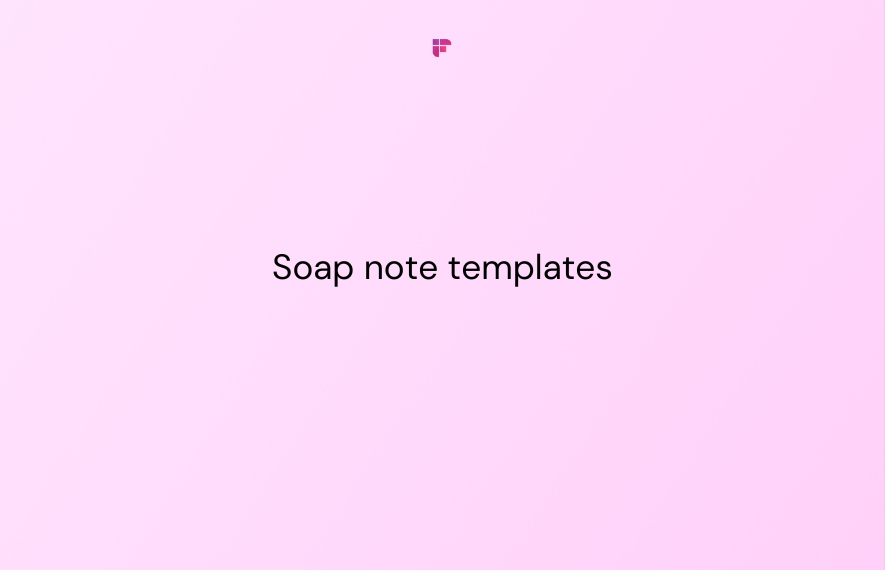Even as the human healthcare system continues to evolve, one thing remains constant —accurate patient documentation.
One easy way to achieve this is by using the SOAP approach. With SOAP notes, you can record patient information, monitor progress, and maintain precise medical records in a well-structured manner.
However, creating these notes from scratch can be a daunting task. That's where SOAP note templates come into play.
In this blog post, you'll discover 10 SOAP note examples to simplify your patient documentation process. These ready-to-use templates will cater to various specialties and align with the latest industry standards.
What does SOAP stand for?

The SOAP is a widely used method of documentation in the medical field that healthcare professionals use to record and communicate patient information effectively.
The acronym "SOAP" stands for Subjective, Objective, Assessment, and Plan.
Let's break down what each of these components entails:
1. Subjective
This section requires you to document your patient's subjective complaints, symptoms, and relevant medical history. It deals with your patient's perspective on their health.
Here's what it should include:
- Chief Complaint: This is the reason why your patient is seeking medical care. It could be an existing issue, a past problem, or a new symptom. It gives a quick overview of the visit's purpose.
So, ask your patients to share all their issues and carefully explore each one to pinpoint which is the most critical. Identifying the primary problem is crucial for an accurate and efficient diagnosis.
History of Present Illness (HPI): This part helps you better understand your patient's complaints. It starts with a short statement, like "18-year-old patient with severe abdominal pain." You can use the "OLDCARTS" acronym to organize the HPI:
- Onset: When did the chief complaint start?
- Location: Where is the chief complaint located in the body?
- Duration: How long has the chief complaint been going on?
- Characterization: How does the patient describe the chief complaint?
- Alleviating/Aggravating factors: What makes the chief complaint better or worse?
- Radiation: Does the chief complaint move to other areas?
- Temporal factor: Is there a specific time when the chief complaint worsens or improves?
- Severity: How bad is the chief complaint on a scale from 1 to 10 (with 1 being the least and 10 being the worst)?
History: This covers the patient's overall health, including:
- Medical history: Relevant past and present illnesses
- Family history: Information on the medical conditions of immediate family members
- Surgical history: Details about past surgeries (if you can, try to include the year of the surgery and surgeon)
- Social history: Lifestyle and environmental factors. An acronym that you can use here is HEADSS, which stands for Home and Environment; Education, Employment, Eating; Activities; Drugs; Sexuality; and Suicide/Depression.
Review of Systems (ROS): This section uncovers symptoms that the patient may not bring up. It checks for general health, gastrointestinal issues, and musculoskeletal problems.
Current Medications: This lists out what medicines the patient is taking, including names, dosages, and how often they take them.
Allergies: Here, you should document any allergies the patient has.
2. Objective
The objective section of your SOAP note should contain factual and objective data from your patient's visit.
Start by recording the patient's vital signs, including temperature, heart rate, blood pressure, respiratory rate, and oxygen saturation.
Next, describe your physical examination findings. Start with your initial impression of the patient and then provide details about the examinations of the head, ears, eyes, nose, throat, respiratory system, cardiovascular system, abdomen, extremities, and nervous system. Include results from any other relevant examinations you've conducted.
Present the outcomes of any diagnostic tests that were conducted, such as:
- Laboratory tests, which include basic metabolic panels, complete blood counts, and liver function tests
- Imaging studies, such as X-rays and ultrasounds
- Any other relevant diagnostic information, including electrocardiograms
Review documentation of other health practitioners (if any.)

3. Assessment
After documenting the patient's subjective and objective information, summarize their condition.
It should include:
- A problem list that lists out each issue in order of importance. A problem is typically considered a diagnosis.
- A differential diagnosis which includes other possible diagnoses (ordered from most to least likely) that could explain the patient's symptoms
4. Plan
This section addresses the need for consultations, additional testing, and details of the treatment plan for your patient's conditions and illnesses.
This part of your SOAP note will help future physicians determine the necessary action.
The plan section should include:
- Which additional testing will be needed, and why it's needed
- Specialist referrals or consultations with other healthcare professionals
- Treatment needed, such as medications or procedures
- Patient education & counseling
💡 Elevate your Clinical Interactions & Document them Safely with Fireflies
Transcribe patient consultations, generate actionable notes, and extract valuable insights from your clinical conversations.

10 SOAP note examples

Here are 10 templates that can guide you when writing your SOAP notes.
1. Therapist SOAP note example
Subjective: The patient reported experiencing symptoms of post-traumatic stress disorder (PTSD) following a recent traumatic event. She described intrusive thoughts, flashbacks, nightmares, and a heightened state of arousal. She also mentioned difficulty sleeping and avoiding reminders of the trauma.
Objective: During the session, the patient appeared anxious and hypervigilant. She reported experiencing flashbacks and was visibly distressed when discussing the traumatic event. No signs of self-harm or suicidal ideation were observed. Her mood was consistently anxious.
Assessment: The patient meets the criteria for Acute Stress Disorder following the recent traumatic event. Her symptoms are significantly impacting her daily life and emotional well-being.
Plan: Trauma-focused cognitive-behavioral therapy (CBT) will be used to address the patient's symptoms and help her process the trauma. Introduce exposure therapy and relaxation techniques to reduce symptom severity. Educate the patient about the course of trauma recovery.
2. Psychiatrist SOAP note example
Subjective: John, a 45-year-old male, reported experiencing recurring episodes of mania, including decreased need for sleep, impulsivity, racing thoughts, and increased energy. They also reported periods of severe depression, marked by low energy, poor concentration, feelings of hopelessness, and suicidal thoughts. John mentioned that these episodes have been recurring for several years.
Objective: During the session, John displayed rapid speech, hyperactivity, and exhibited pressured speech. He reported a decreased need for sleep. No signs of psychosis were observed. John's mood and affect alternated between euphoria during manic episodes and severe depression during depressive episodes.
Assessment: John's presentation is consistent with Bipolar I Disorder. The recurring episodes of mania and depression have had a significant impact on his daily functioning. He is at risk of self-harm during depressive episodes.
Plan: Medication management will be initiated to stabilize mood swings and reduce the frequency and severity of manic and depressive episodes. Regular follow-up appointments will be scheduled to monitor medication effectiveness and side effects. The patient will also be referred to psychotherapy for additional support.
3. Psychotherapist SOAP note example
Subjective: Lisa, a 35-year-old female, reported experiencing ongoing feelings of anxiety and low mood. She mentioned difficulty sleeping and persistent worrying thoughts. Lisa shared that she has been feeling overwhelmed with work-related stress and relationship issues, which have been affecting her daily life and overall well-being.
Objective: During the session, Lisa exhibited signs of restlessness and nervousness. Her speech was rapid, and they appeared tense. She reported a lack of interest in previously enjoyed activities. No signs of self-harm or suicidal ideation were observed. Lisa's mood was consistently anxious throughout the session.
Assessment: Lisa is presenting with symptoms consistent with Generalized Anxiety Disorder and mild depression. The stressors in her life appear to be contributing to their mental health concerns. Further exploration of her work-related stressors and coping strategies is needed.
Plan: Lisa will be encouraged to practice relaxation techniques and mindfulness exercises. Additionally, schedule cognitive-behavioral therapy (CBT) sessions to address her anxiety and depression. Provide psychoeducation on stress management to help her develop coping skills.

4. Speech therapist SOAP note example
Subjective: The client's parents reported concerns about their child's speech development. They mentioned that the child has difficulty pronouncing certain sounds, particularly "r" and "s." The parents are worried about the impact of these difficulties on their child's social interactions and academic performance.
Objective: During the speech therapy session, the child exhibited difficulty articulating the "r" and "s" sounds. The child appeared motivated to improve their speech. No signs of frustration or self-esteem issues were observed.
Assessment: The child presents with articulation difficulties, specifically in producing "r" and "s" sounds. These difficulties may be affecting their overall communication skills and confidence.
Plan: The speech therapist will work with the child to address the articulation difficulties through targeted exercises and techniques. Provided homework assignments to reinforce therapy goals. Progress will be monitored over subsequent sessions to track improvement.
5. Pediatrics SOAP note example
Subjective: The mother of a 6-month-old infant reports that her child has had a fever of 102°F and has been crying persistently for the past two days.
Objective: The infant appears irritable and has a fever, tachycardia, and erythematous tonsils with white exudate, suggesting streptococcal pharyngitis.
Assessment: The infant presents with a febrile illness and clinical signs consistent with streptococcal pharyngitis.
Plan: Perform a rapid strep test and administer acetaminophen for fever management. Advise the mother on appropriate infant care and follow-up.
6. Counselor SOAP note example
Subjective: The patient, a 56-year-old male named Phil, reported ongoing struggles with substance abuse, particularly with alcohol. He shared that their alcohol use has been escalating, leading to relationship conflicts and work-related problems. Phil expressed a desire to quit but feels overwhelmed by cravings and withdrawal symptoms.
Objective: During the session, Phil appeared anxious and reported physical symptoms of withdrawal, including tremors and sweating. He denied any suicidal ideation. Phil's mood was consistently anxious.
Assessment: Phil is dealing with alcohol use disorder, which is impacting their daily life and relationships. He is at risk of experiencing severe withdrawal symptoms if he attempts to quit without support.
Plan: The counselor will work with the client to develop a personalized treatment plan for addressing their alcohol use disorder. This plan may include detoxification, individual counseling, and participation in a support group. Phil will be educated about the nature of addiction and relapse prevention strategies.
7. Dermatology SOAP note example
Subjective: Jane reports having a skin rash on the upper arms that has caused itching and redness for the past week. She notes that the itching has been disrupting her sleep.
Objective: Physical examination reveals erythematous papules with excoriations on the upper arms, and the patient frequently scratches the affected area.
Assessment: Jane presents with a pruritic skin rash consistent with dermatitis. The itching is causing significant discomfort and sleep disturbance.
Plan: Jan will be prescribed a moderate-potency topical corticosteroid to alleviate the itching and redness. Additionally, she will receive education on proper skin care and hygiene practices to manage the dermatitis effectively.
8. Obstetrics SOAP note example
Subjective: A 28-year-old pregnant patient at 32 weeks of gestation expresses concern regarding decreased fetal movements over the last 24 hours. She mentions that the baby's movements are usually more frequent.
Objective: On fetal heart rate monitoring, the baby's heart rate remains within the normal range. However, a significant decrease in fetal movements is observed compared to the patient's previous reports.
Assessment: The patient's report of decreased fetal movements raises concerns about possible fetal distress, and further evaluation is necessary.
Plan: A non-stress test (NST) will be conducted to assess the fetal heart rate reactivity. In addition, an ultrasound will be performed to ensure the baby's health and well-being.

9. Occupational therapy SOAP note example
Subjective: Brad, a 50-year-old patient who recently had a stroke, expresses the inability to use his affected hand for daily activities, including dressing and eating.
Objective: On examination, Brad exhibits muscle weakness and diminished fine motor skills in the affected hand. He struggles to grasp and manipulate objects and has difficulty with fine motor coordination tasks.
Assessment: Brad's current presentation is consistent with impaired hand function and muscle weakness following a stroke.
Plan: Brad will start occupational therapy sessions focused on improving hand strength through exercises, fine motor skill training, and the provision of adaptive techniques to regain independence in daily activities.
10. Urology SOAP note example
Subjective: Hank reports experiencing frequent urination, urgency, and a burning sensation during urination for the past week. He mentions no previous history of urinary issues.
Objective: On physical examination, there are no apparent abnormalities, but urinalysis results reveal the presence of white blood cells and a positive nitrite test indicative of a possible urinary tract infection.
Assessment: Hank's symptoms are consistent with a urinary tract infection (UTI), which necessitates prompt treatment to prevent worsening and potential complications.
Plan: He will be prescribed antibiotics to treat the UTI. Additionally, Hank will receive advice regarding the importance of hydration and managing urinary discomfort.
Streamline your healthcare documentation process with Fireflies
Fireflies is an AI-powered meeting tool that helps healthcare professionals like you to transcribe, summarize, search, and analyze clinical conversations.
This HIPAA-compliant solution ensures accurate and efficient documentation and provides you with meaningful insights from your clinical conversations.

Here's how Fireflies can help you capture and manage sensitive consultation data:
- Provides more than 95% accurate transcriptions of patient consultations in 60+ languages
- Generates concise consultation summaries complete with overviews and time-stamped outlines
- Allows you to search through your transcripts for easy information retrieval
- Provides valuable insights from your clinical conversations to give you a deeper understanding of patient interactions
- Offers a GPT-4 powered bot, AskFred, that you can use to ask questions about consultations
- Integrates with 40+ apps, including major video-conferencing platforms like Zoom & Google Meet. You can also use its API or Zapier integration to send transcripts and notes to EHR systems
- SOC 2 Type II and GDPR Compliant
- Provides HIPAA-compliant Business Associate Agreements (BAAs) for healthcare organizations to guarantee data security and compliance with HIPAA regulations
- Offers Private Storage to provide you with dedicated and isolated data storage for your organization
- Employs robust security practices, including 256-bit AES and 256-bit SSL/TLS encryption, security logging, uptime monitoring, and adherence to OWASP Top Ten coding standards
- Gives admins control over who can access and modify meeting data
To get started with the HIPAA-compliant version of Fireflies, you must request access by filling out a form.

The takeaway
In conclusion, you can use these 10 SOAP templates to ensure your patient records are comprehensive and well-documented.
And don't forget — with Fireflies, you can save time on clinical documentation, maintain accurate medical records, and easily secure your data!





